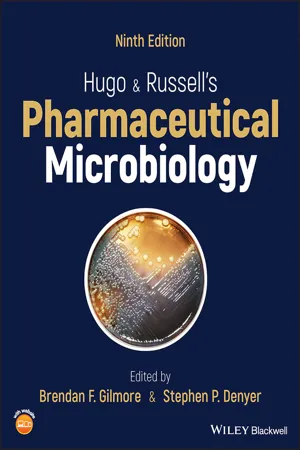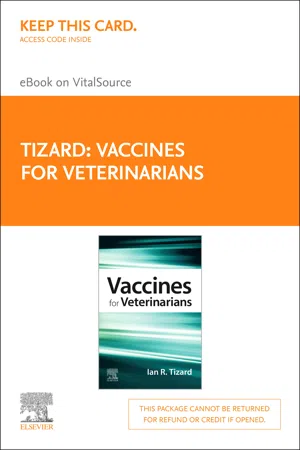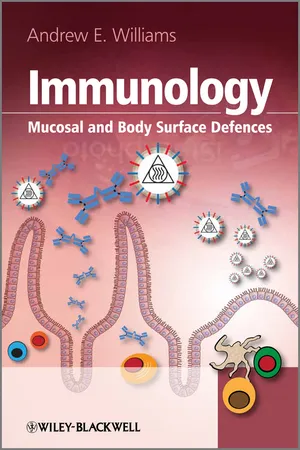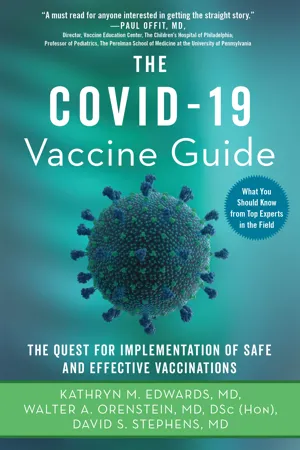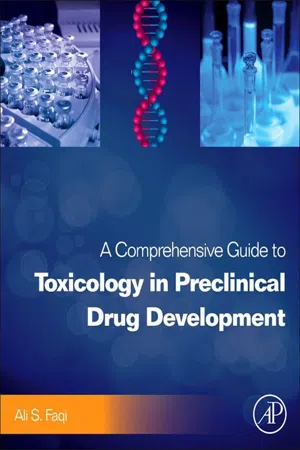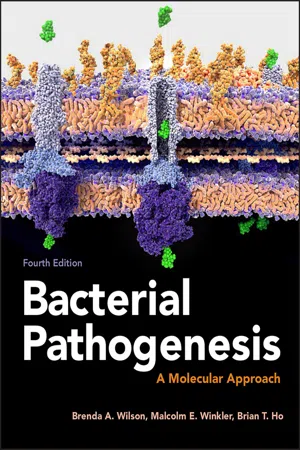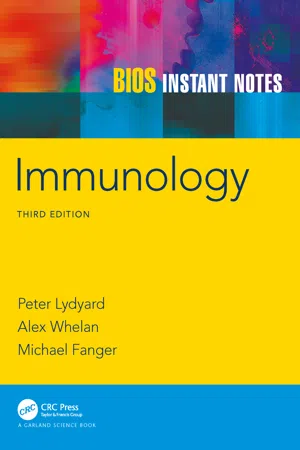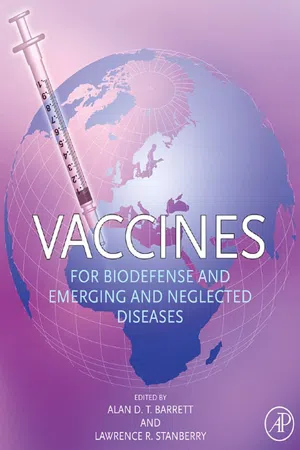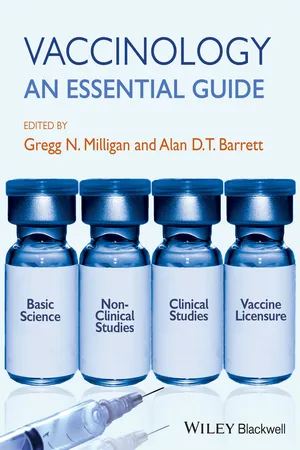Biological Sciences
Toxoid Vaccine
A toxoid vaccine is a type of vaccine that uses a toxin that has been chemically altered to be non-toxic while still retaining its ability to stimulate an immune response. This type of vaccine is commonly used to protect against diseases caused by bacterial toxins, such as diphtheria and tetanus. By introducing the toxoid into the body, the immune system is prompted to produce antibodies, providing immunity against the toxin.
Written by Perlego with AI-assistance
Related key terms
Related key terms
1 of 4
Related key terms
1 of 3
9 Key excerpts on "Toxoid Vaccine"
- eBook - ePub
- Brendan F. Gilmore, Stephen P. Denyer, Brendan F. Gilmore, Stephen P. Denyer(Authors)
- 2023(Publication Date)
- Wiley-Blackwell(Publisher)
Toxoid Vaccines are preparations derived from the toxins that are secreted by certain species of bacteria. In the manufacture of such vaccines, the toxin is separated from the bacteria and treated chemically to eliminate toxicity without eliminating immunogenicity, a process termed ‘toxoiding’. Toxoids are often subject to variable composition depending on the detoxifying agent and method used, and on whether these processes are applied before or after purification.A variety of reagents have been used for toxoiding, but by far the most widely employed and generally successful has been formaldehyde. Under carefully controlled conditions, this reacts preferentially with the amino groups of proteins, although many other functional groups potentially may be affected. Ideally, the toxoided protein will be rendered non‐toxic, but will retain its immunogenicity. The treated toxins are sometimes referred to as formol toxoids.Toxoid Vaccines are very effective in the prevention of those diseases such as diphtheria, tetanus, botulism and clostridial infections of farm animals, in which the infecting bacteria produce disease through the toxic effects of secreted proteins which enzymically modify essential cellular components. Many of the clostridial toxins are lytic enzymes with very specific substrates such as neural proteins. Detoxification is also required for the pertussis toxin component of acellular pertussis vaccines.Anthrax adsorbed vaccine is not toxoided but relies on the use of culture conditions that favour production of the protective antigen (binding and internalisation factor) rather than the lethal factor (protease) and oedema factor (adenyl cyclase) components of the toxin. Selective adsorption to aluminium hydroxide or phosphate also slows release of residual toxin.23.2.1.4 Bacterial Cell Component Vaccines
Rather than use whole cells, which may contain undesirable and potentially reactogenic components such as lipopolysaccharide endotoxins, a more precise strategy is to prepare vaccines from purified protective components. These are of two main types, proteins and capsular polysaccharides. Often more than one component may be needed to ensure protection against the full range of prevalent serotypes. The potential advantage of such vaccines is that they evoke an immune response only to the component, or components, in the vaccine and thus induce a response that is more specific and effective. At the same time, the amount of unnecessary material in the vaccine is reduced and with it the likelihood of adverse reaction. Vaccines that have been based on one or more capsular polysaccharides include: Hib vaccine; the Neisseria meningitidis - eBook - ePub
- Ian R. Tizard(Author)
- 2019(Publication Date)
- Elsevier(Publisher)
Cl. perfringens act in a similar matter.Toxoids are safe and cannot revert to virulence. They cannot spread to other animals. They are very stable and resistant to damage by temperature and light. They generally induce good humoral immunity but not cell-mediated immunity. As with other nonliving vaccines, toxoids are not always highly immunogenic. As a result, multiple doses may be needed to assure immunity. Additionally, an adjuvant, usually an aluminum salt, must be incorporated into the vaccine. Local reactions such as redness, swelling, and induration at the injection site may develop within a few hours. These usually resolve within 72 hours.Conventional immunological wisdom would suggest that the use of antibodies against tetanus toxin (tetanus immune globulin) should interfere with the immune response to toxoid and must therefore be avoided. This is not a problem in practice however, and both may be successfully administered simultaneously (at different sites) without problems. This may be because of the relatively small amount of immune globulin usually needed to protect animals.Bacterin-toxoids
Some veterinary vaccines combine both toxoids and killed bacteria in a single dose by the simple expedient of adding formaldehyde to a whole culture. These products, sometimes called anacultures or bacterin-toxoids, are used to vaccinate against Clostridium haemolyticum and Cl. perfringens. Trypsinization of the mixture may make it more immunogenic. Other bacterin-toxoids may have improved efficacy by adding other purified immunogenic antigens. For example, Escherichia coli bacterins against enteric colibacillosis in calves and pigs may be made more effective by the addition of additional fimbrial adhesion proteins such as F4 (K88), F5 (K99), F6, F7, and F18. Antibodies to these antigens prevent Escherichia coli binding to the intestinal wall and thus contribute significantly to protection. Similarly, Mannheimia - eBook - ePub
Immunology
Mucosal and Body Surface Defences
- Andrew E. Williams(Author)
- 2011(Publication Date)
- Wiley(Publisher)
The current influenza virus vaccine, administered to high-risk populations in order to prevent epidemics of the flu, is based on inactivated virus. The influenza vaccine is trivalent and consists of three different virus strains, which are chemically inactivated. The influenza A virus strain(s) (highly pathogenic) likely to circulate in the following season are predicted and incorporated into the vaccine together with an influenza B virus strain (mildly pathogenic). Influenza viruses are identified by the type of haemagglutinin and neuraminidase (H and N) proteins they possess. For example, the current vaccine contains H1N1 and H3N2 virus haplotypes plus a strain of influenza B virus (such as the Beijing or Hong Kong strain). However, the inactivated influenza vaccine is not always protective, due to changes in the influenza virus strain as a result of antigenic drift (single mutations in the H and N genes) or antigenic shift (re-assortments of whole gene segments, e.g H3N2 to H5N2). The vaccine is then rendered non-protective as the immune system has never encountered the new virus strain and so the threat of an influenza epidemic or even a pandemic remains. Recent concerns have arisen due to geographically isolated human outbreaks of H5N1 virus, a haplotype thought only to be a problem in birds. Efforts are now being made to produce a H5N1 virus vaccine, although this virus is toxic to chicken embryos, the preferred medium for vaccine virus growth.An example of an inactivated bacterial vaccine is the formaldehyde inactivated whole-cell pertussis vaccine (WCPV) administered in childhood for protection against whooping cough. This was first administered in 1914 in the USA and consists of inactivated Bordetella pertussis absorbed onto aluminium salt as an adjuvant. WCPV is usually given in combination with diptheria toxoid and tetanus toxoid (DTwP). A toxoid is the chemically inactivated form of the toxin that causes disease. Although the DTwP vaccine was responsible for a massive decline in the incidence of whooping cough, diptheria and tetanus, some individuals had adverse reactions to the vaccine. The preferred trivalent diptheria, tetanus, pertussis (DTP) vaccine contains an acellular pertussis vaccine (DTaP) containing one or more inactivated components B. pertussis , including the toxin and filamentous haemagglutinin antigen. However, the DTaP vaccine is less efficacious than the DTwP vaccine and requires repeated immunizations.17.15 Polysaccharide VaccinesPolysaccharide vaccines are also known as conjugate vaccines and consist of bacterial polysaccharides conjugated to proteins. They have been very successful in preventing diseases caused by certain bacteria that possess a polysaccharide capsule, such as Neisseria meningititis (meningitis), Haemophilus influenzae type b (meningitis) and Streptococcus pneumoniae - eBook - ePub
The Covid-19 Vaccine Guide
The Quest for Implementation of Safe and Effective Vaccinations
- Kathryn M. Edwards, Walter A. Orenstein, David S. Stephens(Authors)
- 2021(Publication Date)
- Skyhorse(Publisher)
There are many types of vaccines. The first vaccines developed were modeled on those of Jenner and included related viruses or bacteria that infected animals and were able to induce cross-protective immunity against human pathogens, when injected into humans. Examples of these vaccines include the previously mentioned smallpox vaccine used by Jenner and another animal bacteria from cows, called BCG, that is administered to children in developing countries to protect against tuberculosis. Next came killed whole viruses or bacteria with an excellent example being the inactivated or killed polio vaccine (IPV) developed by Jonas Salk, which became available in 1955. Another vaccine in this category includes a virus to prevent hepatitis (inflammation of the liver) called hepatitis A.Some bacteria cause disease by excreting potent substances, called toxins, into the body. There are ways to chemically alter these toxins so they no longer cause disease but do stimulate a protective immune response. These are called “toxoids” and the major examples of these are toxoids to prevent tetanus and diphtheria, which are given as part of the combined diphtheria, tetanus, and pertussis (DTP) vaccine. Another example of the use of proteins released from an organism to produce vaccines is the acellular pertussis or whooping cough vaccine, which contains several of these purified proteins from the pathogen (called Bordetella pertussis ) and used as a vaccine.A major breakthrough in vaccinology came with the development of live attenuated or weakened pathogens that through repeated passage in the laboratory lost their virulence but maintained their ability to induce a protective immune response. Examples of these vaccines include those against measles, mumps, rubella, varicella (chickenpox), and yellow fever. The organisms in these vaccines can reproduce in the body following administration, cause the immune system to recognize them as foreign, and thereby induce the immune system to make and sustain a protective immune response.Some bacteria have capsules made of complex sugars, called polysaccharides, to protect the bacteria. Another class of vaccines induce the immune system to make antibodies against these polysaccharides and protect the body from diseases these bacteria cause. Sometimes these polysaccharides do not induce a protective immune response by themselves, particularly in young children. But when the polysaccharides are chemically linked to proteins, they become better able to stimulate a potent immune response. These are called protein-polysaccharide conjugate vaccines. Examples of such vaccines are the pneumococcal conjugate vaccine, which protects against common causes of severe pneumonia and the meningococcal conjugate vaccines that protect against epidemic meningitis. - Ali S. Faqi(Author)
- 2012(Publication Date)
- Academic Press(Publisher)
Chapter 25
Preclinical Toxicology of Vaccines1
Martin David Green and Nabil Hussain Al-Humadi Center for Biologics Evaluation and Research (CBER), Food and Drug Administration (FDA), Rockville, MarylandOutline
Introduction to Vaccines/Adjuvants for the Prevention of Infectious Diseases Special Topics Adjuvants Aluminum Adjuvants (Salts) Toxicities Associated with Vaccines Toxicology Studies for Vaccines (Adjuvants) Types of Study and Their Endpoints Single- and/or Repeat-Dose Toxicology Studies Reproductive and Developmental Toxicology Studies Mutagenicity Studies Carcinogenicity Studies Safety Pharmacology Studies Other Toxicity Studies Animal Models for Vaccine Research Influenza Vaccines and the Selection of the Appropriate Animal Model Mice, Cotton Rats and Guinea Pigs Ferrets Pigs and Cats Monkeys The Selection of Animal Models for Other Vaccines Routes of Vaccine Administration Intranasal Vaccines Alternative Routes Vaccine Injection versus Intranasal Administration (Live Attenuated Vaccines versus Killed Vaccines) Product Characterization Pediatric Drug Development (Preclinical Safety Evaluations) ReferencesIntroduction to Vaccines/Adjuvants for the Prevention of Infectious Diseases
Vaccines are biological preparations that a\ugment immunity to targeted diseases. These biological preparations stimulate the recipient’s immune system to recognize targeted aspects of infectious organisms as foreign and generate host mechanisms to control or eliminate them. Additionally, they evoke mechanisms to form an immunological memory of the antigen(s) which provides efficacy against future infections by the same or similar organisms.Vaccines are created from inactivated or attenuated organisms, or are derived from purified or recombinant sub-components of these organisms. They provide antigens that may be incorporated into vaccines composed of peptides, proteins, and polysaccharides. They may also be indirectly introduced to the host immune system through recombinant DNA plasmids or chimeric virus vectors. Inactivated vaccines are killed through the use of heat or chemicals, whereas attenuated vaccines contain live, less virulent organisms. Often these vaccines are derived from live viruses that have been cultured under conditions that disable their pathogenic properties. Attenuated vaccines often produce a durable immunological response and, thus, are preferred for many classes of infectious agents. Subcomponents of micro-organisms may also be used as antigens in vaccines. For example, Toxoid Vaccines are made from inactivated toxic components and offer protection from the effects of the infection. Additionally, fragments or subunits of an attenuated or inactivated micro-organism can also be used as the basis of an antigenic response to a vaccine. Subcomponents may also be used for other purposes, for example, poorly immunogenic components of micro-organisms can be improved by their conjugation to proteins which typically are toxins. This approach is often used in conjunction with polysaccharides, which form the outer coat of some infectious bacteria such as Haemophilus influenzae- eBook - ePub
ASM Books
A Molecular Approach
- Brenda A. Wilson, Malcolm Winkler, Brian T. Ho(Authors)
- 2019(Publication Date)
- ASM Press(Publisher)
There is a serious flaw in relying on herd immunity, however, given the increase in international travel. Children who have not been immunized against viral diseases, such as measles and mumps, and who have been protected from measles and mumps during childhood years due to the herd effect, would be ill advised to travel during their adult years to areas of the world where measles is still endemic, as noted previously. For reasons that are still not well understood, many of these diseases have a much more serious effect if they strike teens or young adults than if they occur in children. Parents who refuse to have their children vaccinated are setting those children up for a dangerous future.Vaccine Success StoriesVaccines against smallpox, a viral disease, and diphtheria, a bacterial disease, have virtually eradicated these diseases in countries with vaccination programs in effect. A good vaccine can provide lifelong immunity to an infectious disease by stimulating long-lived effector and memory T cells and B cells, as described in chapter 4 . Some of the vaccine success stories are summarized in Table 17-3 . We will now focus on a few of those successful vaccines that are specific for bacterial diseases.Subunit VaccinesMost successful vaccines used today against bacterial pathogens work by inducing humoral immunity against bacterial antigens that are relatively invariant (e.g., secreted toxins or surface proteins). A great example of this is the trivalent DTaP vaccine used to protect against diphtheria, tetanus, and whooping cough. These diseases are caused by protein toxins released into the bloodstream by invading bacteria. An effective way of counteracting these circulating toxins is through the production of neutralizing antibodies. The DTaP vaccine works by stimulating the production of these antibodies. Vaccines like DTaP are called subunit vaccines because they consist of one or more purified proteins that have been inactivated through heat or chemical treatment. The inactivated forms of the toxin proteins or their subunits are referred to as toxoids. These toxoid-based vaccines are administered extracellularly, and so they primarily elicit a humoral antibody response rather than a cell-mediated response (see chapter 4 - eBook - ePub
- Peter Lydyard, Alex Whelan, Michael Fanger(Authors)
- 2011(Publication Date)
- Taylor & Francis(Publisher)
SECTION I – VACCINATION
I1 Principles of vaccination
Key NotesPrinciples of vaccination The primary goal in vaccination is to provide protective immunity by inducing a memory response to an infectious microbe using a nontoxic antigen preparation. It is important to produce immunity of the appropriate kind: antibody and/or cellular immunity. Antibody-mediated protection against microbes Antibodies produced as a result of immunization are effective primarily against extracellular organisms and their products, for example toxins. Passively administered antibodies have the same effect as induced antibodies. Cell-mediated immune protection against microbes Cell-mediated immunity (T cells, macrophages) induced by vaccination is important particularly in prevention of intracellular bacterial, viral, and fungal infections. Related topics (E3) The cellular basis of immune responses (F1) The role of T cells in the antibody response Principles of vaccination
Edward Jenner, a country physician in England, noticed that dairymaids who frequently contracted cowpox were often immune to the ravages of smallpox, leading him to develop an approach whereby cowpox was used to vaccinate people against smallpox. The term vaccination is derived from the Latin word vaccinus meaning “from cows.” Vaccination eventually resulted in the complete eradication of smallpox (in 1980) and has been generalized as a reliable method of protection against many pathogens.The aims of vaccination are to induce memory in T and/or B lymphocytes through the injection of a nonvirulent antigen preparation. Thus, in the event of an actual infection, the infectious agent and/or its toxin are met by a secondary rather than a primary response. The ideal vaccine would protect the individual and ultimately eliminate the disease, but most vaccines simply protect the individual. A standard set of vaccines is now in use worldwide, some of which are (or should be) given to everyone, others to those particularly at risk (Table 1 - Alan D.T. Barrett, Lawrence R. Stanberry(Authors)
- 2009(Publication Date)
- Academic Press(Publisher)
2. The routes of administration that have been the focus of most research are intramuscular and subcutaneous injection. Clearly, this is not ideal. Other routes of administration are superior, both in practical terms and in clinical terms.3. The duration of vaccine action that has been sought, at least implicitly, is one that is lengthy and may approximate that of the tetanus vaccine. Once again, this is not ideal. Although the concept of seeking a vaccine with a limited duration of action may seem counter-intuitive, there are compelling reasons to pursue this course of action.An examination of the literature on the structure of the botulinum toxin molecule, as well as the history and clinical presentation of the disease botulism, provides ample evidence to support these three conclusions. This examination also suggests that there are rational ways in which investigators can translate the first and second conclusions into authentic vaccine candidates. Additional information will be needed to translate the third conclusion into practice.Selection of Antigen
There are relatively sound bases for identifying vaccine candidates that would be desirable, those that would be of questionable value, and those that are not worth pursuing. Beginning with the latter, there is no obvious reason to pursue an attenuated vaccine. Although it is true that most cases of naturally occurring botulism are due to primary infection, the actual number of cases is so small that there is no impetus to develop a vaccine against the organism. In addition, primary intoxication is far more likely than primary infection to be the mode of any acts of bioterrorism or biological warfare, so again there is little impetus for seeking an attenuated vaccine.In the category of vaccines that are of questionable value, perhaps the most obvious example would be the one aimed at auxiliary proteins in the progenitor toxin complex. Vaccination with these polypeptides has not yielded an efficacy equivalent to that which is customary with vaccines directed against the neurotoxin or its subunits (Mahmut et al., 2002- eBook - ePub
Vaccinology
An Essential Guide
- Gregg N. Milligan, Alan D. T. Barrett, Gregg N. Milligan, Alan D. T. Barrett(Authors)
- 2014(Publication Date)
- Wiley-Blackwell(Publisher)
The golden hamster is used as a model for yellow fever virus (YFV) disease and for the immune response to immunization with both live and attenuated YFV vaccines. Golden hamsters vaccinated with the candidate YF XRX-001 vaccine developed significant titers of YFV neutralizing antibody and when challenged with virulent virus, 90% of animals with neutralizing antibody titers greater than 39 survived the challenge with a lethal dose of the wild-type virus. Additional passive antibody studies revealed animals with neutralizing antibody titers greater than 40 were completely protected from disease as evidenced by viremia, liver enzyme level, weight change, and death.Nonclinical Vaccine Safety and Toxicity
Studies to support safety of vaccines as biologics are significantly different from those designed to evaluate small molecules. Vaccines are produced by living cells and may undergo degradation during production. They can exaggerate pharmacological and toxicological responses and may be species specific. Regardless, the purpose of nonclinical toxicology/safety vaccine studies of small molecules and vaccines is the same. In the latter stages of vaccine development, when a process for preparation of vaccine for the phase I study has been confirmed, a toxicology/safety study needs to be conducted to determine safety of the vaccine for human studies. Vaccine toxicology studies are designed to identity target organs of toxicity and are ultimately used to establish safe starting doses of vaccine for clinical trials, as well as identify areas of concern for clinical safety monitoring. Vaccine toxicology studies are done with different types of products including inactivated /nonliving antigens and live attenuated organisms. Inactive non-replicating proteins or carbohydrates (e.g., tetanus toxoid, diptheria toxoid, S. pneumoniae
Index pages curate the most relevant extracts from our library of academic textbooks. They’ve been created using an in-house natural language model (NLM), each adding context and meaning to key research topics.
Explore more topic indexes
Explore more topic indexes
1 of 6
Explore more topic indexes
1 of 4
